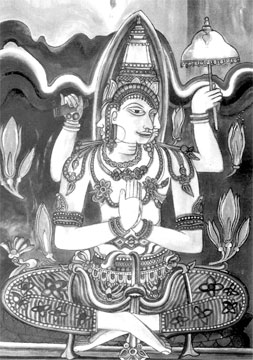|
Contemporary Painters
Amarasena Kodithuwakku:
An artist moved by emotions
Since the study of heredity is not an exact science, every man is
biologically just what one would have expected or what one would never
have expected or, most often, confused mixture of both. The subject of
this biographical sketch is an unusually a pure specimen of the first of
these classes. Almost everything he has done and the way in which he has
then it have origins which are his own.
He stands on his own feet as a painter and artist. He is none other
than Amarasena Kodithuwakku. He was born in Nawimana, a small village
close to Matara, the natural splendour of the rural landscape with
coconut trees heavy with greenish nuts, luxuriant green paddy fields,
the wonderful panorama of mountains, with the river winding like a
silver ribbon would have made him a nature lover.
 |
|
Amarasena Kodithuwakku |
 |
|
One of his paintings |
He had his early education at St. Thomas' College, Matara. In 1958 he
entered the College of Fine Arts, where he was fortunate to study under
distinguished senior art teachers such as David Paynter, Stanley
Abeysinghe, S. P. Charles and W. A. Ariyasena.
During his long years in the Department of Education as an art
instructor he taught at Medagama Maha Vidyalaya, Bibile where he won
first place at the All Island Poster Competition in 1967.
Amarasena is one of the most versatile and original artists of his
generation.
He trained as a decorative painter and also painted scenery and
styles traditionally associated with it. He took a tremendous interest
in contemporary art and reserved his strongest enthusiasm for past
masters for their creativity.
A characteristic of his work is the great sensitivity to materials
and a love of abstracts.
However, comparing his original work exhibited in his previous
exhibitions it is clearly evident that he has turned towards new visual
experiences, depicting his own style.
His colours are bright, simple and clear mostly based on human forms.
It has high quality generating a true awakening. He regarded his
subjects without illusions but with intimate knowledge.
Some of his paintings are abstract while a very modern trend too had
found its way into them. 'Taking his bride home' (oil on canvas) depicts
an exuberant village youth taking his bride home after the wedding and a
cart drawn by a majestic looking bull decked in royal splendour. The
focal-point of the painting was the animal. His love for animals was
evident.
The oil on canvas had splashy greens and blues mixing into a haze of
arabesque. His painting 'Mother and Child', implying that the mother's
affection transforms her blood into breast milk. In several respects his
methods are radically different and rare from those generally followed.
He paints on paper with a nonabsorbent surface. The successive washes
enable him to obtain a richness of colour scarcely possible by
traditional procedure.
The work of Amarasena is rare indeed of his generation, a unique
variety which includes book covers, magazines and press designs,
illustrations and advertisements. For a brief period he was working for
a advertising agency in Colombo, where he worked as a creative director.
He has held many art exhibitions at the Lionel Wendt, The National Art
Gallery and Alliance Francaise. He hopes to have another exhibition in
Colombo this year. Today in retirement, Amarasena is relaxed and ready
to devote more time to his much loved subject.
|

